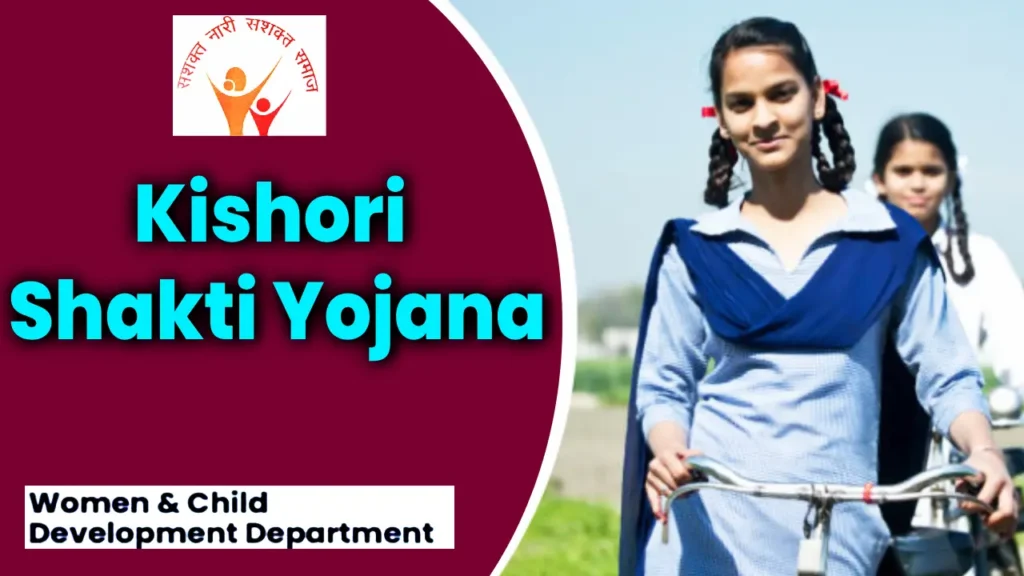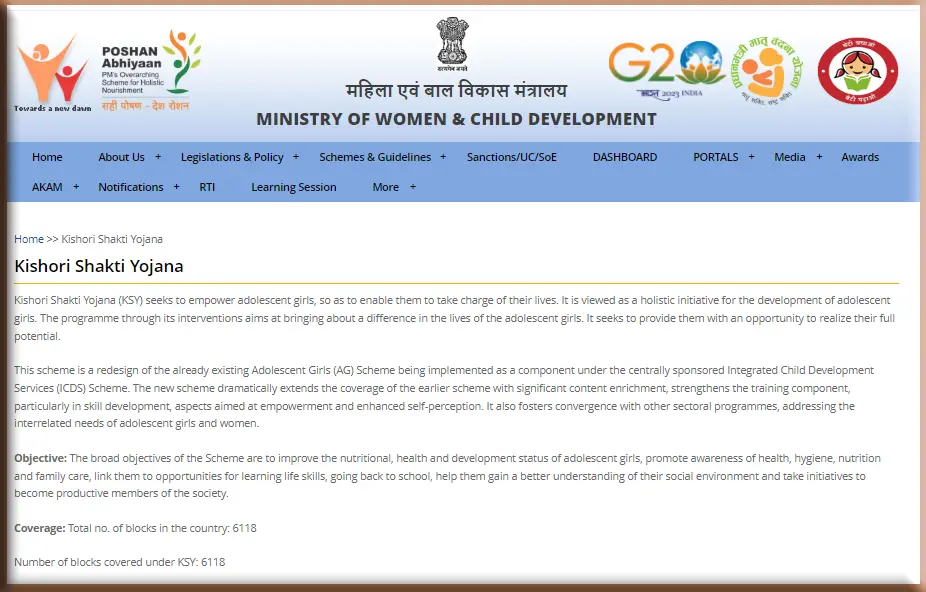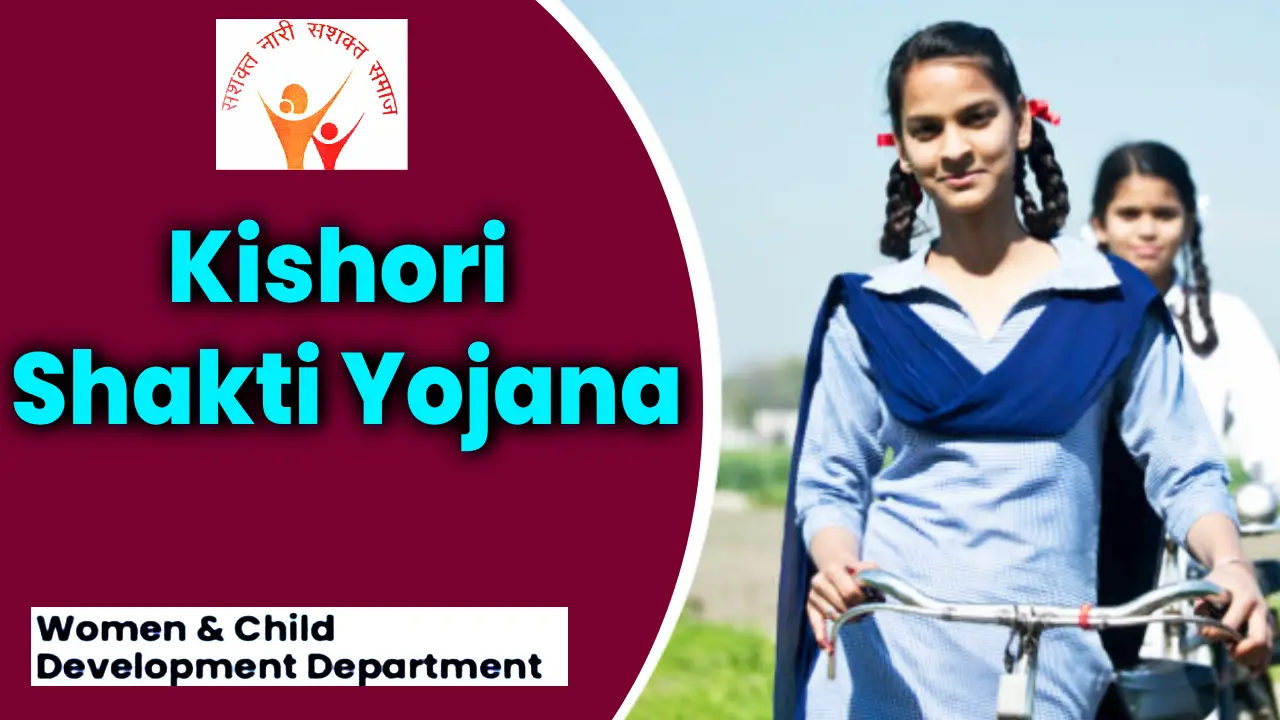Kishori Shakti Yojana 2024: Kishori Shakti Yojana (KSY) 2024 is a comprehensive program that the central government has introduced to empower teenage girls. The goal of the latest Kishori Shakti Yojana is to empower young girls to take ownership of their lives and achieve prosperity.
To learn how to get the rules in PDF format for किशोरी शक्ति योजना, as well as information on the launch date of KSY and other scheme details, read this article through to the conclusion. କିଶୋରୀ ଶକ୍ତି ଯୋଜନା ଓଡ଼ିଶା ପଞ୍ଜୀକରଣ, ଆବେଦନ ର ସମ୍ପୂର୍ଣ ବିବରଣୀ।
What is Kishori Shakti Yojana?
The primary goal of the KSY program is to empower and encourage adolescent girls between the ages of 11 and 18 so they may actively participate in the growth and well-being of their families and communities. Through its initiatives, the Kishori Shakti Yojana program seeks to improve the lives of teenage girls. It aims to allow people a chance to reach their greatest potential.
| Yojana Name | Kishori Shakti Yojana |
| Started By | Central Government of India |
| Started On | 01 Nov. 1991 |
| Scheme Under | Integrated Child Development Services (ICDS) |
| category | Sarkari Yojana |
| Benefits | Teenage Girl Will Reach Her Greatest Potential |
| Official Website | https://wcd.nic.in |
| Objective | Empower Young Girls |
| Beneficiary | Adolescent Girls (Between The Ages Of 11 And 18) |

Launch of the Kishori Shakti Yojana
The program for teenage girls began to run on November 1st, 1991. The program is now known as the Kishori Shakti Yojana. The beneficiaries receive additional nutrition through ICDS under the Supplementary Nutrition Program since there is no separate budget available and nutrition must come from the State Sector.
Redesigned as part of the centrally supported Integrated Child Development Services (ICDS) Scheme, Kishori Shakti Yojana 2024 is an extension of the Adolescent Girls (AG) Scheme. The new KSY program significantly broadens the scope of the previous program while enhancing its content. It also reinforces the training element, especially with regard to skill development and components that promote empowerment and improved self-perception. Additionally, by addressing the interconnected needs of adolescent girls and women, it promotes convergence with other sectoral programs.
Adolescent Girls Scheme Modification to KSY
Since many baseline surveys make it abundantly evident that adolescent girls’ health, nutrition, education, and social standing are below ideal levels, the previous program for adolescent girls has been updated. According to the surveys, adolescent girls also lack sufficient access to important health and nutrition-related information, services, and programs that could improve their nutritional and overall health status and foster self-development, awareness of health, hygiene, nutrition, and family welfare and management.
It is commonly known that when these programs are offered, women’s decision-making skills and their children’s health and nutritional condition could both be much improved. The State Governments and UT Administrations have also consistently demanded that adolescent girls in all ICDS Projects receive coverage for ICDS immediately.
Because of this, it has been determined that the program needs to expand its coverage to include more enriching content, improve its training component—especially with regard to vocational aspects that aim to empower and improve self-perception—and create convergence with other programs that are similar in nature in the areas of education, employment, rural development, and health. Therefore, updated guidelines have been provided to State Governments and UT Administrations for the AG scheme’s implementation as an ICDS scheme component. The scheme is now known as Kishori Shakti Yojna in all ICDS Projects.
Download the PDF guidelines for Kishori Shakti Yojana
As previously indicated, the Kishori Shakti Yojana is a modified version of the former Adolescent Girls (AG) plan. Thus, we are now offering the download link for the Kishori Shakti Yojana Guidelines.
| Kishori Shakti Yojana Details | Click Here |
| Kishori Shakti Yojana Guidelines | Click Here |
The Kishori Shakti Yojana Objectives
In addition to providing facilities for recreation and entertainment, the Kishori Shakti Yojana seeks to educate teenage girls about the importance of personal hygiene, environmental sanitation, health and nutrition education, nutrition, child care and development, home nursing, first aid, family life, etc. Additionally, efforts must be made to update and expand locally available home-based talents that are well-liked in trades or have potential. The following are the Kishori Shakti Yojana’s goals:
- To enhance the health and nutritional status of females between the ages of 11 and 18.
- To assist children develop their ability to make decisions, to instill a desire for greater social interaction and knowledge, and to impart the necessary literacy and numeracy skills through non-formal education.
- To teach and provide teenage girls with the tools they need to advance their domestic and professional abilities.
- In order to facilitate their marriage only after they turn eighteen, or even later, we must raise understanding of health, cleanliness, nutrition, family welfare, home administration, and child care.
- To learn more about the social concerns pertaining to their surroundings and how these affect their life,
- To inspire teenage females to take the lead in many endeavors in order to become helpful and productive members of society.

The Kishori Shakti Yojana Benefits
- The following common services will be provided to all teenage girls between the ages of 11 and 18: Educational activities through non-formal and functional literacy patterns.
- Vaccination
- a biannual general health examination
- Therapy for mild illnesses
- Deworming
- preventative steps against vitamin deficits, goiter, anemia, etc.
- referral for urgent care to the District Hospital or PHC
- merging with the Reproductive Child Health Program.
Under the initiative, any single teenage females between the ages of 11 and 18 who hail from rural families with annual incomes under Rs. 6,400/-will be eligible to get additional services.
Girl to Girl Method (For Girls in the 11–15 Year Age Range)
Two girls between the ages of eleven and fifteen will be chosen from each Anganwadi region that has been selected. These teenage girls would be fed a meal equivalent to that of a nursing mother or pregnant woman, which would be 500 calories and 20 grams of protein.
The two girls who have been identified will receive six months of in-service training from the worker and supervisor at the Anganwari to enable them to become fully qualified individuals capable of running the center independently. This will enable them to fully realize the goals of the Anganwari worker in all areas, such as store management, feeding program organization, vaccination schedules, child weighting, home visits, preschool activities, etc.
Balika Mandal (For Females in the 15–18 Age Range)
While it is important to focus on adolescent girls from the very beginning, that is, when they are 11 years old and older, the critical period in terms of their transition to maturity begins as they approach the age of 15. The program thus focuses primarily on the social and mental development of girls, ages 15 to 18. A particular focus would be on encouraging and including the ignorant segments of this age group in non-formal education as well as the development and enhancement of skill-based at home.
Duration of Active Kishori Shakti Yojana Enrollment
Adolescent girls need to receive non-formal education, have better reading skills, and have better home-based abilities. The duration of a teenage girl’s active enrollment in the Balika Mandal differs for each adolescent girl dependent on her prior educational background, her ability to grasp, whether or not she possesses a home-based skill, and other related considerations.
However, in order to determine the required amount of funds, it is assumed that a teenage girl may participate in a Balika Mandal for six months on average, with an average of roughly 20 teenage girls attending; each Balika Mandal may serve up to 40 teenage girls annually.
Key Aspects of the Kishori Shakti Yojana
- Coverage: Every block in the nation
- Target Audience: Teenage Girls (Ages 11–18)
- Facilities for infrastructure: Current ICDS infrastructure
- Financial Requirements: Rs. 1.10 lakh annually for each ICDS project
- The source of the information is:- https://wcd.nic.in/kishori-shakti-yojana
- You can also use ( as a source of information):- http://www.wcddel.in/ksy.html
FAQs of the Kishori Shakti Yojana
What is the Kishori Shakti Yojana scheme?
The goal of Kishori Shakti Yojana (KSY) is to provide adolescent females with the necessary tools to take control of their lives. It is seen as an all-encompassing program for teenage females’ growth. It is the program’s goal to improve the lives of teenage females through its interventions.
What advantages does the Kishori Shakti Yojana offer?
to enhance the health and nutritional status of females between the ages of 11 and 18. To assist children develop their ability to make decisions, to instill a desire for greater social interaction and knowledge, and to impart the necessary literacy and numeracy skills through non-formal education.
What is the Kishori Shakti Yojana known by another name?
The Odisha government is implementing the Kishori Shakti Yojana, also known as the “Adolescent Girl Empowerment Scheme,” for juvenile girls between the ages of 11 and 18 as part of the Integrated Child Development Services (ICDS) government program. The initiative was started by the Ministry of Women and Child Development in India.
What is Odisha’s Sabla scheme?
The primary goal of this program is to lower the dropout rate among adolescent girls by raising their rate of literacy and employment. Give adolescent girls the tools they need to grow into independent adults.
What does ICDS stand for in full?
In India, Integrated Child Development Services (ICDS) is a government program that offers mothers and children under six years old wholesome meals, preschool instruction, primary healthcare, vaccinations, health examinations, and referral services.
